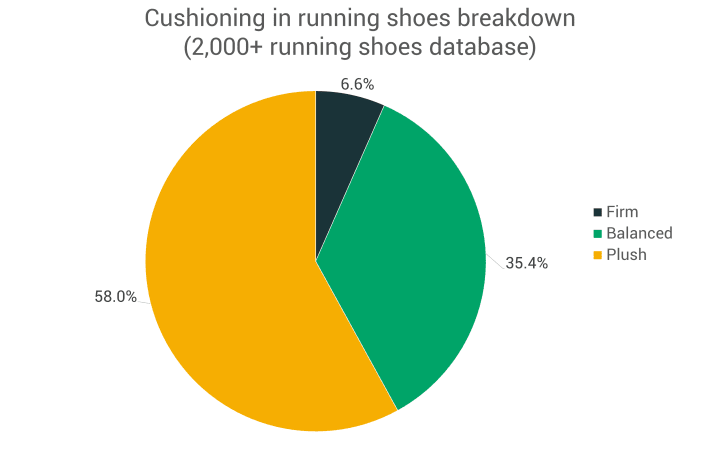3 softness levels of running shoes
Based on how soft the shoes feel, we categorize them into these 3 categories:
- Firm running shoes
- Balanced running shoes
- Plush running shoes.
Given that softness of the shoe is directly related to perceived comfort, it makes sense that the majority of shoes are described as plush. This is based on the biggest running shoe database (2,000+ shoes):

The difference between firm, balanced and plush running shoes
| Cushioning | Features and purpose |
| Firm (hard) | Often lower-stacked and aggressive looking, used for quick transitions. Greater midsole hardness results in shorter contact time (source). Much less shock absorption than in soft shoes. Average stack height: 26.4mm (6.5-35mm range). |
| Balanced | Perfect balance between comfort and performance. Usually used in workhorse shoes (used for daily running, tempo runs and racing). Average stack height: 25.7mm (6-40mm range). |
| Plush (soft) | Plush shoes offer maximal impact protection and are usually high-stacked. Best for long runs, recovery runs, marathons, ultras. Also great for beginners. Average stack height: 26.9mm (7-50mm range). |
Examples of firm (On Cloudswift), balanced (ASICS Gel Kayano 28) and plush (Nike ZoomX Invincible Run) shoes:

Runners prefer soft running shoes
These shoes have a soft or plush underfoot experience. That experience can be felt at the forefoot (under the toes), under the heel, or both. Given that 94% of runners are heel strikers, most shoes are focused on offering soft experience in the heel area or throughout the whole midsole.
Self-perception of the forefoot and rearfoot cushioning (examined in this study on heel-striking runners):
- Runners prefer softer shoes.
- Cushioning under the heel mattered more in the perception of overall cushioning: soft-heel/hard-forefoot shoes were perceived similar to soft shoes, while hard-heel/soft-forefoot shoes were perceived as medium shoes.




